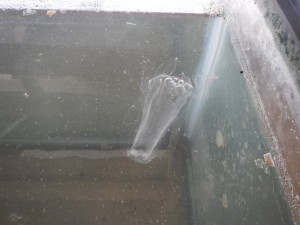Just when I thought my efforts were futile in finding the elusive jellyfish and ctenophores around Glovers, this afternoon my colleagues managed to find for me six box jellyfish wash up on shore! And as a bonus, the whole group was preparing for a taxon group exhibition where we have specimens to display and explain to each other. I was able to harvest the 6 jellyfish, being wary to not touch the notoriously venomous tentacles. In most cases, handling a box jellyfish by the head (bell) is harmless, though some species are known to contain stinging cells on their head, but those variants only occur in parts of Australia.
The species of box jellyfish found was Alatina alata, the same as the jellyfish first found. Their stings are known to cause something called Irukandji syndrome, a life threatening condition that manifests in symptoms like headache, body pains, vomiting, a sense of impending doom, and hypertension. Pretty scary. A scary fact about jellyfishes is that even though most of the specimens were dead they could still sting. During my presentation, a large sign hung over me saying, DO NOT TOUCH! I hope I didn’t worry my instructors too much!

Even though these guys were scary to handle, I had so much fun looking at these dangerous creatures close up. I was able to show my class the tiny complex eyespots embedded in the jellyfish. One question I have is why these 6 jellyfish all beached at Glovers at the same time? Were they traveling as a group or was it just coincident beaching? If they were traveling as a group, are jellyfish capable of social behaviors? Questions abound, but this has definitely been an exciting turnaround in my jellyfish adventures.
One thing I should point out, box jellyfish aren’t in the same class as “true” jellyfish. They have different complexities of their nervous systems in spite of sharing a similar body plan. Let’s see if I can find anymore jellyfishes on our trip to the mangroves this next morning!
Other than the amazing box jellyfish beaching, we dissected some lionfish that we captured a day before to analyze their health and stomach contents. Lionfish are invasive species and eat basically anything, so our info may shed light into how these guys are doing in the Caribbean. Once we finished dissection, we made ceviche out of them! Delicious science and an interesting way to end our last full day at Glover’s.
